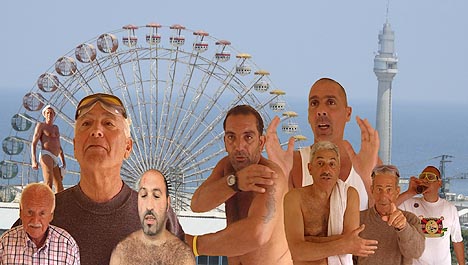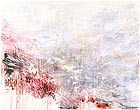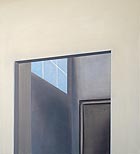
translated and summarized by: Liz Wollner-Grandville,
English summary September 14 - 20
Istanbul Biennial
Under the sign of Bertolt Brecht
The 11th International Istanbul Biennial undertook an extreme balancing act. “What keeps mankind alive?” - the song title from Berthold Brecht’s “A Threepenny Opera” is written across an exhibition banner. WHW, the Croatian curator collective and its members Ivet Curlin, Ana Devic, Natasa Ilic and Sabina Sabolovic, attempted to radiate a 1920-style glamour. But the question was: with which visual forms of language and grammar will WHW respond to the global economic situation, which cynically received the name “crisis” only in 2007.
Evidently the symbols must be inspired to dance; in an emancipated way - as a sequel to the dynamics of previous Istanbul biennials. In view of a trembling megacity, which is not patchwork, but a work of patches stretched to the breaking point. A city with intertwined districts and life plans, whose mycelia cords of architectural growths, which dramatically reflect the economic contrasts and their dizzying wage and price differences, while the sign language of Islamic everyday life and Turkish scenes meld/interlink.
At this venue, it seems equally logical to explicitly force socio-economic forms of art as well as positioning the diversity of contemporary art. However, this leads to flaws and polarisations. The outposts of the exhibition at Tütün Deposu, a former tobacco warehouse and the Ferlköy Rum Okulu school, which was closed down in 2003, are too linear, formally monotonous and somewhat like visual allegories. At the central location of the show, the warehouse Antrepo No. 3, next to the Museum Istanbul Modern near the Galata Bridge – a differentiated net of formally diverse positions of critical art are assembled forming a concentrated exhibition, which seduces one to follow topical and semiotic tracks from different junctions.
Decoded works that draw on the art of cartography as well as critical political realities, as those by the Slovenian Marko Paljhan or the French bureau d’études, are contrasted by an installation of the Argentinean group “Etcétera…” (Loretto Garin Guzman, Federico Zukerfeld), who, similar to Peter Sloterdijk in his “Critique of Cynical Reason”, present the Errorist cabaret (2009) as a walk-in Dada-installation: a cabaret-like puppet theatre in historic space geography. George W. Bush Jr. appears in addition to philosophers, revolutionaries and pioneers of science, such as Sigmund Freud.
In her lovingly made and amusing multi piece video installation, the Lebanese artist Mounira Al Solh dubbed males with female voices as they- standing in front of the concrete buildings and the jagged rocky coast line of Beirut - are recounting their daily swimming pleasures. An ethnographic view on body cult and male friendship complemented by photographs and a collage, which precisely characterize the locations of the action like a 3D storyboard; and all this in a section, which deals with gender, emancipation and working conditions (for women). Among them a photo series by the German Hans Peter Feldmann, which records 50 years of a conventional female life, excerpts from Michel Journiac’s work and Canan Senol’s animation video “Ibretnüma /Exemplary” (2009). Figures presented as if in a zograscope, partly like cutout sheets from One Thousand and One Nights and from cheap fashion magazines, comment on role attributions and paradigms of the suppression of Turkish women. Numerous historic film works complement all of this. That is exactly the way in which exciting ways of thinking evolve for interconnecting the aesthetic with the social.
By Roland Schöny
Istanbul Bienniale
Istanbul, until 08.11.09
www.iksv.org/bienal11/
MUMOK Museum moderner Kunst: Cy Twombly – Sensations of the Moment
The last Informal
George Mathieu’s theory of Informal Art is one of the last master tales of Modernism. Convinced of historic logic, the theory discourses about the cyclicality of morphology. From a condition of shapelessness the figurations develop a sovereignty, take shape, convert to symbols of harmony and equilibrium, develop further, flow into something bizarre and eccentric, become pretentious, to finally wither and drown in a pool of the unidentifiable. Following the atrocities of Auschwitz and Hiroshima, this is the condition of Informal Art that Mathieu saw perfectly clearly.
The theory of the Informal is the tersest alternative draft to the progress-drunkenness of Modernism with its ideas on self-criticism and the radicalisation for the better. Informal Art has, despite Mathieu’s theatricality; something pausing, sceptic if not despairing, and it are European to the bone. That its most renowned representative is an American fits perfectly into the ‘concept of paradox’.
Anyway, Cy Twombly has been living in the capital of the old continent for half a century. He came to Rome in 1960, the centre of “Dolce Vita” and for a short period the trendsetting-centre. Twombly stayed, and concentrated on his foible for the ancient world, its myths, and their survival, their legacy and their renaissances. Above all, his titles deal with history’s audacity; call on “Arcadia”, remind of Rafael’s school of Athens as well as Pan, Sappho, and Orpheus.
Twombly’s canvases, and later his sculptures, live on the allusion, the impression, the afflatus of a motif. What he does on the surfaces, sounds like a noise or looks like a phenomenon, dainty, hardly capable of living under the massive presence of that what denies itself to be associated in these pictures. Because this is the first impression: many kinds of traces have left themselves behind, of pencils, of crayons and other tools, but they are not assignable, they exist as monuments of their own informality.
This kind of autonomy is typical for the global language of abstraction. But behind all of this murmuring and rumbling one begins to hear a sound, and it sounds classic. You have to take a close inspection and a world of topics and great messages becomes audible, this archive of meanings, which once stood for the word iconography. For fifty years now, Twombly does nothing but give this iconography its Modernism. With its fabulous presentation the MUMOK looks over his shoulder. And he wisely leaves his most recent works to the collection Brandhorst.
By Rainer Metzger
MUMOK Museum moderner Kunst
1070 Vienna, MuseumsQuartier, until 26.10.09
www.mumok.at
Kunsthaus Bregenz: Antony Gormley
Bunker for the collective
The citizens of Malmo most probably have never seen themselves lined up so disciplined in a square shape as in “Allotment II”. Antony Gormley gauged and reconstructed the body architecture of 300 people from the southern Swedish city, aged between 1 and 80. Their sizes and orifices (mouth, ears, anus, nostrils) are the only leftovers of their individuality, which were transferred to the square shaped concrete bunkers. Now the citizens of Malmo stand like a faceless, massive armada in the first floor of the Kunsthaus Bregenz and testify the British sculptor’s interest in the human body as an individual and as a collective, as a mantle, but also as the core of existence.
At the same time as this exhibition, Gormley wanted to realize his landscape installation “Horizon Field”, in which 100 iron castings stand in a horizontal line, 2000m above sea level, in an area of one hundred square kilometres of the Arlberg region (similar to 1997, when he positioned iron castings of his own body in the Wadden Sea at Cuxhaven). Complicated approval procedures delayed the project, but four major work series from Gormley’s oeuvre, all created during the last 15 years, are presented at the Kunsthaus. Among them “Critical Mass” (1995): the body is transformed into a container for traumatic memories, maybe of torture and war, maybe simply of his very own transience. Identical cast-iron figures are spread throughout the space; they hang from the ceiling, squat on the floor like penitents, snuggle up in a shifted sitting position in a corner and cumulate to a gruesome-grotesque heap in the middle. The figures “Body” and “Fruit”, although weighing several tons, convey lightness. What remained of the body is a shapeless pendulum, floating barely above the ground, a peculiar planet. Sometimes Gormley’s attempts to involve the onlooker in his sculpture-driven ideas blossom on a metaphysical level and sometimes on a concrete physical level. In “Clearing V” (2009) a gigantic aluminium pipe entangles itself in the space as if someone had knotted it tightly together and suddenly let go, and, as if after an explosion, it stretches into every corner of Peter Zumthor’s architecture. And now one has to find one’s way through this entanglement: maze-like steeplechases seem to be fashionable; think of Tomas Saraceno’s web-like mesh in the main pavilion of the Venetian Giardini, albeit which one happily and easily wriggled through. But the crudeness and tonicity of the material bestow “Clearing” a different kind of quality. Ultimately, however, the contortions remain the same.
By Ivona Jelcic
Kunsthaus Bregenz
6900 Bregenz, Karl Tizian Platz, until 04.10.09
www.kunsthaus-bregenz.at
Startgalerie im Museum auf Abruf: Fabian Patzak – Someplace Next Year
A master of reduced architectures of desire
If there is something like a young, contemporary generation of painters, and if, as it seems, they show a strong interest for rooms and especially for room paintings, then Fabian Patzak is doubtless one of their most prominent representatives. The atmosphere of his very reduced, almost shy, oil paintings, remind of Edward Hopper or Charles Sheeler, albeit Patzak’s are even more reduced, as they are always painted tone on tone. And even without knowing the titles, his works are always 100 percent American rooms, reminding of film classics by Hitchcock, Woody Allen, or the New York Trilogy by Paul Auster. Rooms that narrate about amplitude and openness, but also of the intensity of New York as the artists’ metropolis - without being dramatic or kitschy. His oil on wood miniatures possess an even more fascinating intensity: among them a window onto Oxford Street, resembling a linocut and thereby breaking the sobriety of the topic in a subtle way.
The basic sentiment of being alone, which distinguishes this generation of young Viennese artists, is conveyed intensively in Patzak’s work. This loneliness is mediated by the emptiness, which dominates the room paintings in this exhibition. One is literally pulled into these completely non-kitschy idylls and begins to enjoy the quiet and vastness, because - even if might not sound like that - Fabian Patzak’s paintings are anything but depressive or melancholic. Yes, he actually seems to paint the silence in the middle of the invisible turmoil. He paints what could be seen, if all unclear, hectic, confusing things would disappear from the scene and the pure “now” would be left over. In this way the presented works are architectures of desire, which are capable of mediating this silence.
By Wolfgang Pichler
Startgalerie im Museum auf Abruf
1010 Vienna, Felderstrasse 6-8, next to the Town Hall, until 03.10.09
www.musa.at/startgalerie
Mehr Texte von translated and summarized by: Liz Wollner-Grandville


 Teilen
Teilen





